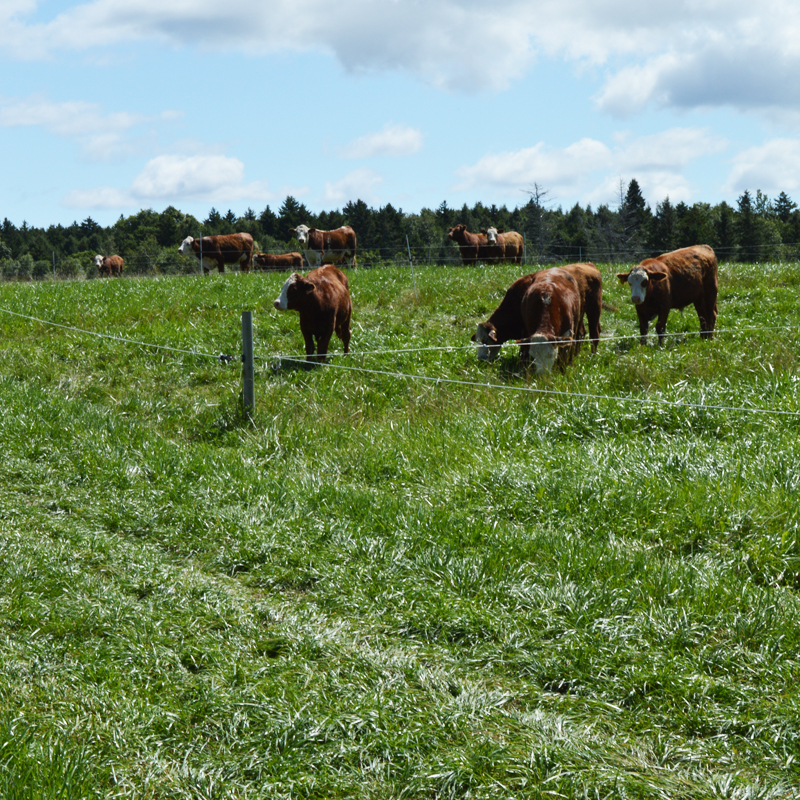Pasture Blends
This article written by Dr. Reynold Bergen, BCRC Science Director, originally appeared in the February 2018 issue of Canadian Cattlemen magazine and is reprinted on the BCRC Blog with permission of the publisher.

Most forage seed companies offer a pasture blend. Some customize their blend to the customer’s situation, but others use a least-cost formulation to produce a more attractively priced blend. Ideally, the blend should contain grasses and legumes that grow well together, are well-adapted to the environment and soil type they will be seeded in, will tolerate grazing, and produce good animal performance. Seed companies often don’t have all the information they need to formulate these ideal blends. As one example, forage breeding plots are typically far too small to graze, so forage yield is evaluated using a plot harvester. This means that forage varieties are being selected for their ability to produce and recover from mechanical harvesting rather than grazing. Forage improvement programs that integrate the breeding, agronomics, and grazing management research programs to gather the data needed to develop effective pasture blends take a long time and are very costly.
To help address this issue, the Beef Science Cluster has been supporting research led by Dr. Yousef Papadopoulos at Agriculture and Agri-Food Canada’s Experimental Farm in Nappan, Nova Scotia. Part of this research program is examining long-term trends in forage yields, nutritional value, animal performance and species composition of complex grass-legume blends.
What they Did:
Four different combinations of timothy, meadow fescue, reed canarygrass, Kentucky bluegrass, tall fescue, meadow brome, and orchardgrass were seeded with either birdsfoot trefoil or alfalfa in the spring of 2010.
The grass-legume paddocks were rotationally grazed from May through October starting in 2011 through 2016. Grazing began when forage was at least 25cm high, and allowed to recover until it was 25cm tall again. Depending on rainfall and temperature, cattle were cycled through each paddock two to seven times per grazing season. Small sections were clipped before each grazing cycle began to estimate forage yield and quality (e.g. total digestible nutrients, fiber, crude protein, sugars). The proportion of grasses and legumes was also determined at least twice per grazing cycle.
What they Learned:
Five full grazing seasons at Nappan have been completed. Generally speaking, the legume that was included in the blend had a much greater impact on forage yields, forage quality and animal performance than the specific grasses in the blend.
Average forage yields between 2011 and 2016 averaged 10 to 20% higher for the seed blends that included alfalfa as the legume than for those that included birdsfoot trefoil. In terms of forage quality, crude protein averaged 18 to 25% higher and total digestible nutrients averaged 3 to 4% higher for the blends that contained alfalfa than for those that included birdsfoot trefoil. The ratio of sugars to crude protein averaged 50 to 78% higher for blends that contained birdsfoot trefoil than for those that contained alfalfa.
In contrast, average animal performance between 2011 and 2016 was better on the blends that contained birdsfoot trefoil than for those that contained alfalfa. Daily gains on the birdsfoot trefoil stands averaged 2 to 6% higher, adding up to 30 to 44% greater total animal gains per acre over the grazing season. The researchers attributed this to the higher sugar:protein ratio on the birdsfoot trefoil blends, suspecting that rumen bacteria may digest and synthesize protein more efficiently when an readily digestible sugar is available. Birdsfoot trefoil also contains condensed tannins, which may reduce protein digestion in the rumen. Having that protein digested in the small intestine instead of by the rumen bacteria may contribute to more efficient animal growth.
Legume persistence: Initially, all of the forage stands contained 25 to 30% legume, but the alfalfa and birdsfoot trefoil had virtually disappeared from all of the stands by the fifth year of grazing. Not surprisingly, forage yields fell by 20% to 30% as the legumes dwindled. Because the legume component of the forage blends appeared to explain most of the differences in forage yield and animal performance outlined above, it’s not surprising that differences in forage yields and animal performance between the blends that contained alfalfa and birdsfoot trefoil were also much smaller by year five.
What it Means:
If you’re in Nappan and want a seed blend for grazing, consider one that contains birdsfoot trefoil. If you’re growing hay to sell by the ton, a blend containing alfalfa may be a better choice. But some of the growing season length, soil pH, moisture, and temperature conditions that are common in Nappan don’t represent conditions elsewhere in Canada. In fact, this trial originally had additional AAFC sites in Kapuskasing ON and Brandon MB until those sites were shuttered in 2012 and 2013. That’s unfortunate, because the legume and grass blends used in this study at Nappan would probably rank differently in other locations. That emphasizes the importance of having regionally appropriate research and extension activities throughout Canada to develop forage establishment, management, and grazing strategies that will optimize beef production per acre while finding ways to maintain or reestablish legumes in older mixed grass stands.
Click here to subscribe to the BCRC Blog and receive email notifications when new content is posted.
The sharing or reprinting of BCRC Blog articles is typically welcome and encouraged, however this article requires permission of the original publisher.
We welcome your questions, comments and suggestions. Contact us directly or generate public discussion by posting your thoughts below.